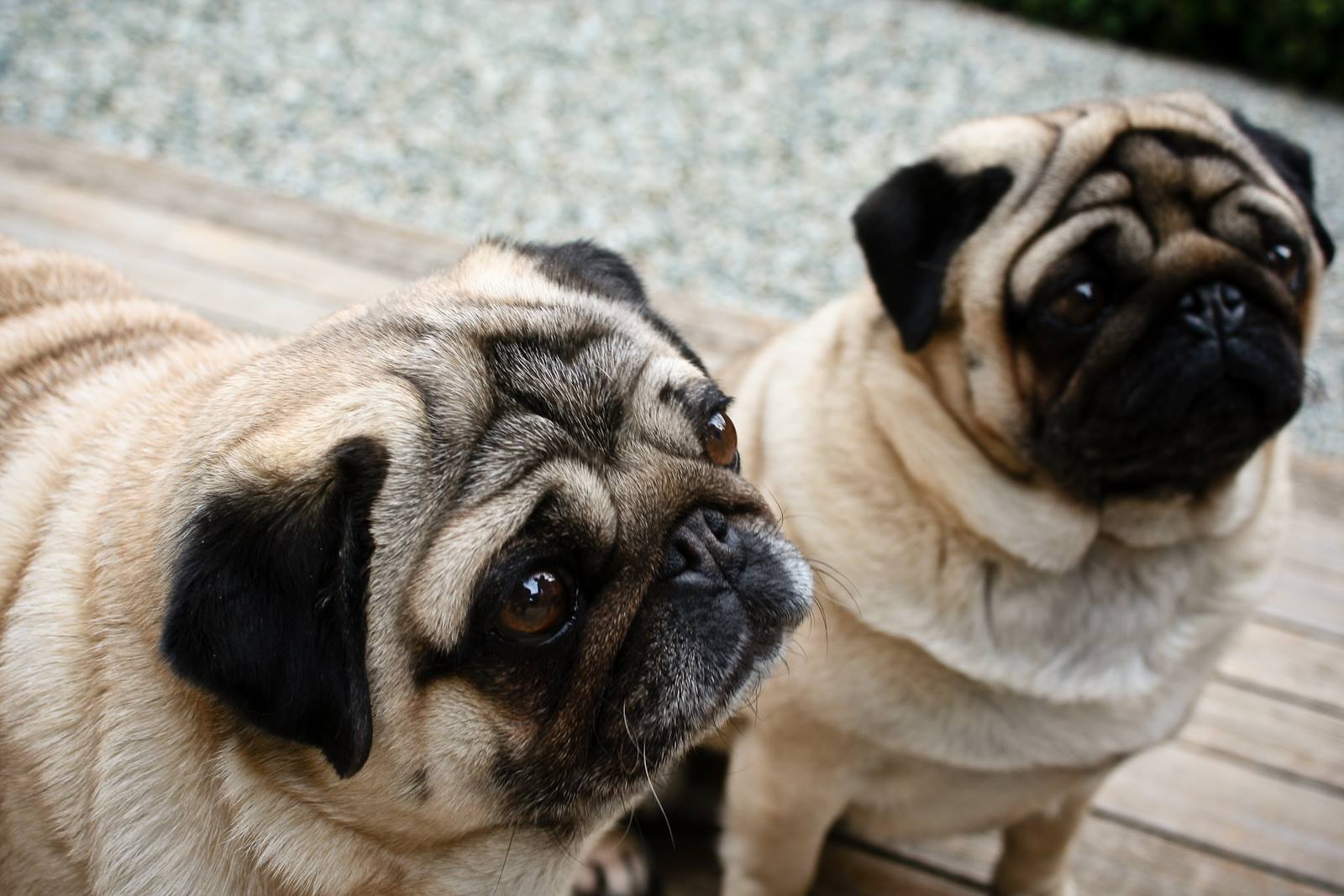The versatility of the Pug breed shines through in whatever performance activity you and your companion decide to do!
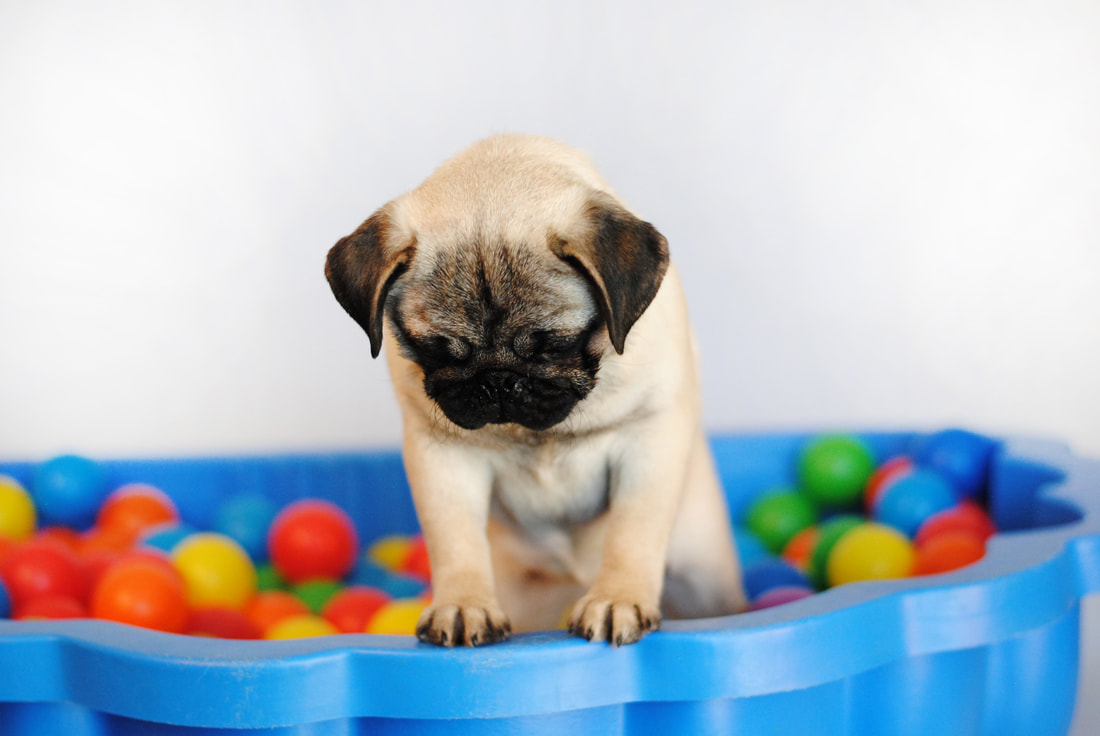
Nosework
PUGS can do many sports and Nosework is definitely one of them. Proudly presenting “ROMEO “, ORYAN’S SUGARBEAR FINDERS KEEPERS who earned Nosework Championship from Sporting Detection Dogs Association (SDDA) Canada. He also became the very first ELITE Pug in Canada. Caroline McCormick and Machiko Nomura are thrilled and very proud of Romeo and his handler, Debbie Wixalbrown.

Inspirational, Entertaining, Devoted
Mother Like Daughter!
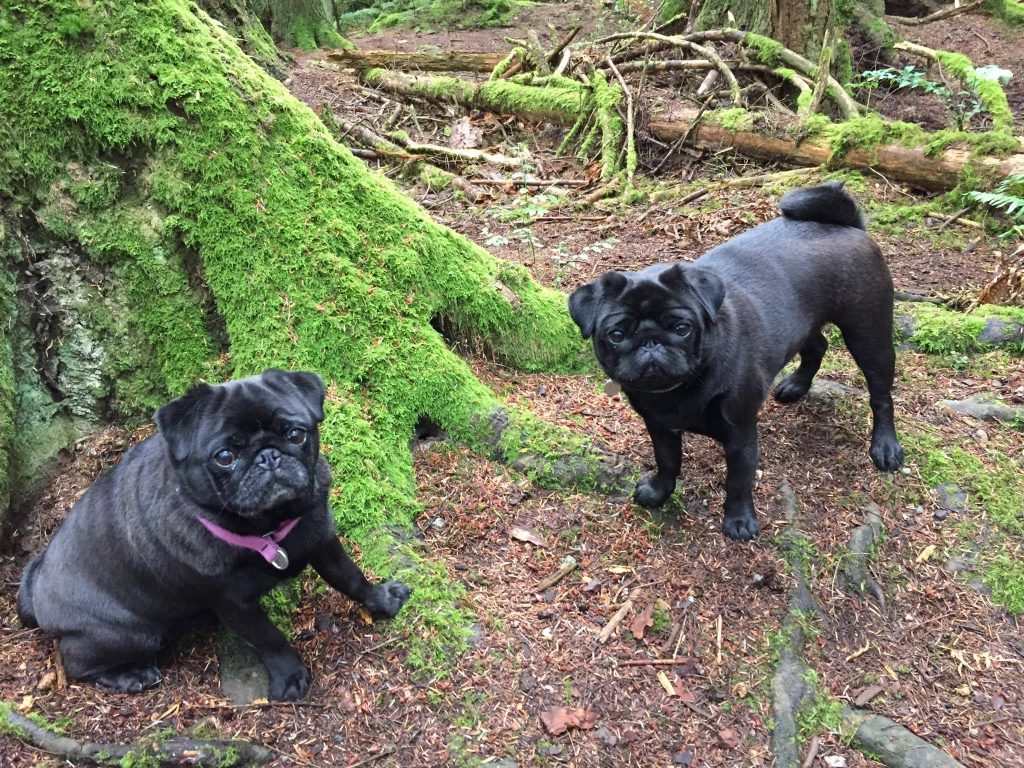
Prada & Pippa
Owner Machiko Nomura
Mother and daughter team, Prada, Pippa attended Lower Mainland Dog Fanciers of BC, CKC Scent Detection Sanction Match.
Agility
Rueben James & Crowley – Owners Raye Vaillancourt & Tracey Silverthorn
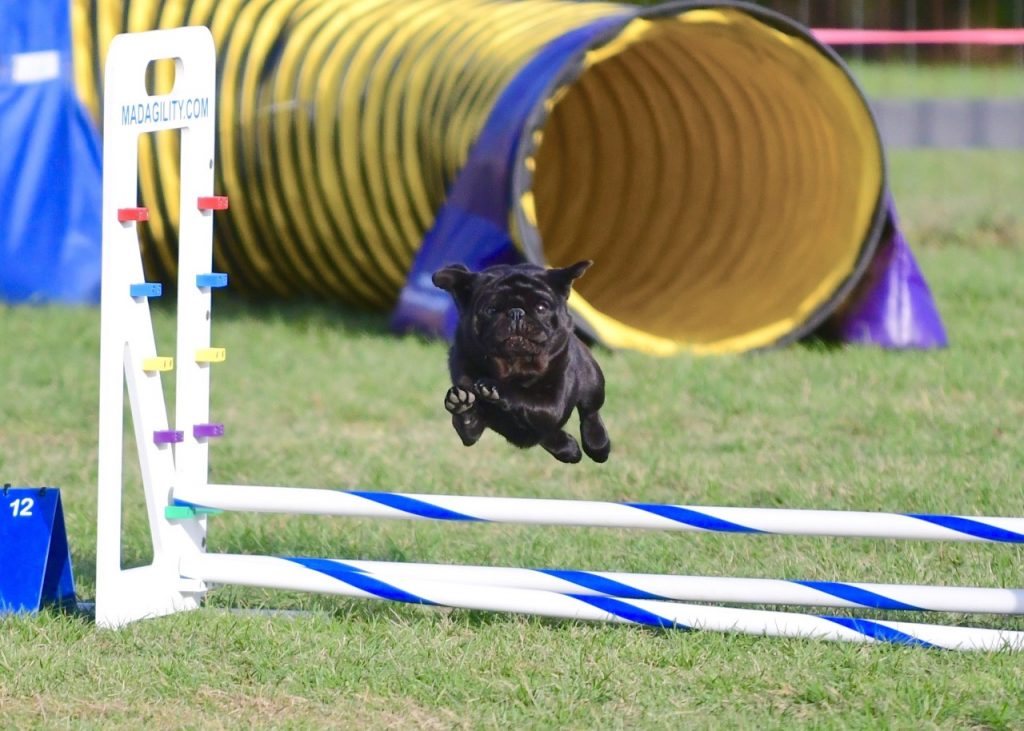
Donny showing excellent drive during his agility jump!
Owner Ashley Fischer
Wobble Board Training
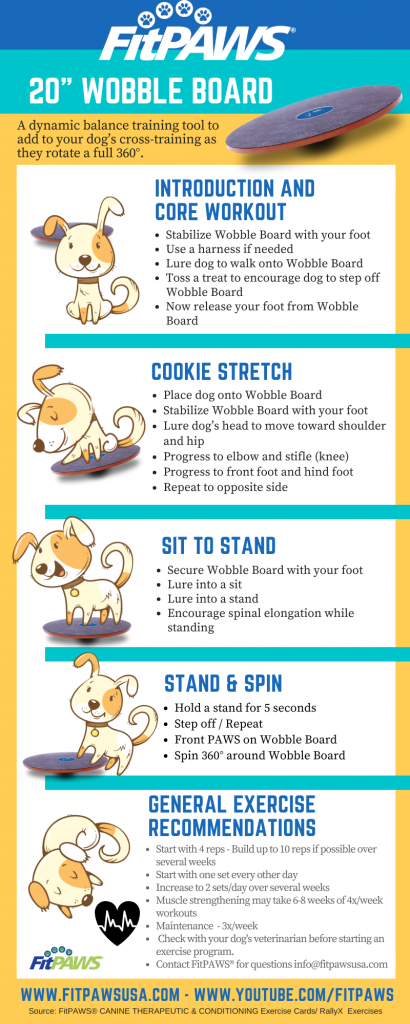
Enrichment Games for you and your Pug

Obedience
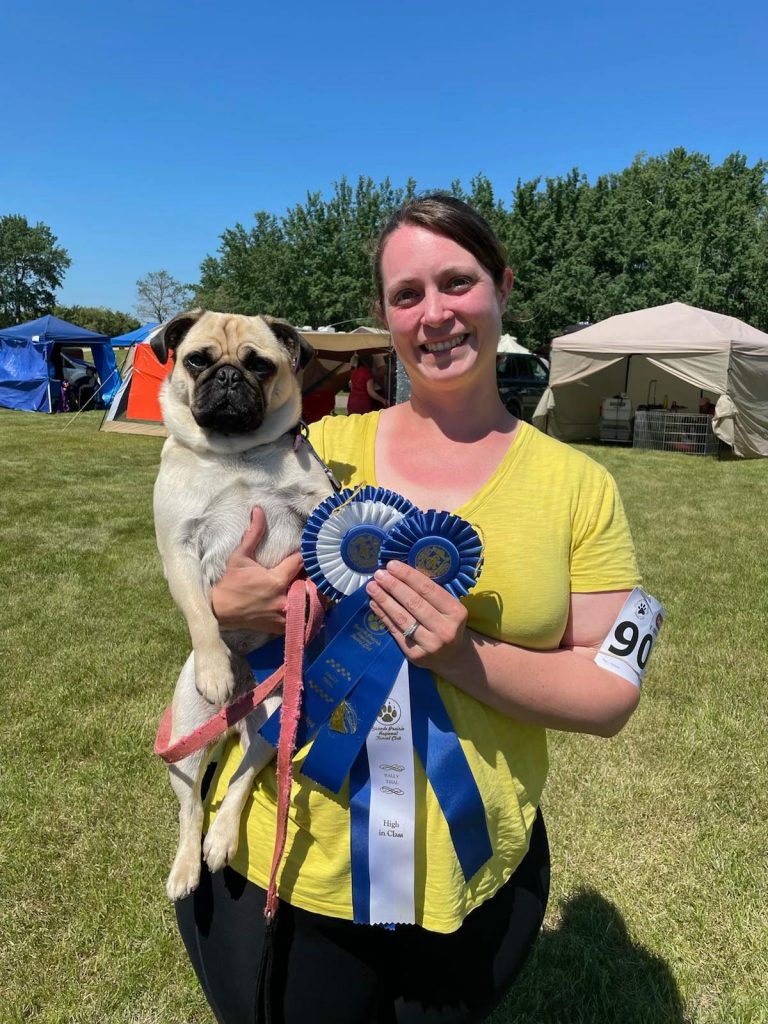
Brains and Beauty!
Peppa – High Score In Trial (H.I.T.)
Owner Alicia MacDonald
5 Essential Training Commands to Teach Your Pug
Sit
This is one of the easiest dog obedience commands to teach, so it’s a good one to start with.
- Hold a treat close to your dog’s nose.
- Move your hand up, allowing his head to follow the treat and causing his bottom to lower.
- Once he’s in sitting position, say “Sit,” give him the treat, and share affection.
Repeat this sequence a few times every day until your dog has it mastered. Then ask your dog to sit before mealtime, when leaving for walks, and during other situations where you’d like him calm and seated.
Come
This command can help keep a dog out of trouble, bringing him back to you if you lose grip on the leash or accidentally leave the front door open.
- Put a leash and collar
on your dog.
- Go down to his level and say, “Come,” while gently pulling on the leash.
- When he gets to you, reward him with affection and a treat.
Once he’s mastered it with the leash, remove it — and practice the command in a safe, enclosed area.
Stay
Before attempting this one, make sure your dog is an expert at the “Sit” command.
- First, ask your dog to “Sit.”
- Then open the palm of your hand in front of you, and say “Stay.”
- Take a few steps back. Reward him with a treat and affection if he stays.
- Gradually increase the number of steps you take before giving the treat.
- Always reward your pup for staying put — even if it’s just for a few seconds.
This is an exercise in self-control for your dog, so don’t be discouraged if it takes a while to master, particularly for puppies and high-energy dogs. After all, they want to be on the move and not just sitting there waiting.
Down
This can be one of the more difficult commands in dog obedience training. Why? Because the position is a submissive posture. You can help by keeping training positive and relaxed, particularly with fearful or anxious dogs.
- Find a particularly good smelling treat, and hold it in your closed fist.
- Hold your hand up to your dog’s snout. When he sniffs it, move your hand to the floor, so he follows.
- Then slide your hand along the ground in front of him to encourage his body to follow his head.
- Once he’s in the down position, say “Down,” give him the treat
, and share affection.
Repeat it every day. If your dog tries to sit up or lunges toward your hand, say “No” and take your hand away. Don’t push him into a down position, and encourage every step your dog takes toward the right position. After all, he’s working hard to figure it out!
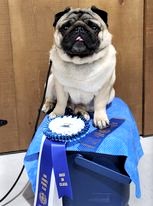
Workability in a small package!
Sammich, CD, CGN
Owner Anne Pogontsis
Leave It
This can help keep your dog safe when his curiosity gets the better of him, like if he smells something intriguing but possibly dangerous on the ground! The goal is to teach your pup that he gets something even better for ignoring the other item.
- Place a treat in both hands.
- Show him one enclosed fist with the treat inside, and say, “Leave it.”
- Let him lick, sniff, mouth, paw, and bark to try to get it — and ignore the behaviors.
- Once he stops trying, give him the treat from the other hand.
- Repeat until your dog moves away from that first fist when you say, “Leave it.”
- Next, only give your dog the treat when he moves away from that first fist and also looks up at you.
Once your dog consistently moves away from the first treat and gives you eye contact when you say the command, you’re ready to take it up a notch. For this, use two different treats — one that’s just all right and one that’s a particularly good smelling and tasty favorite for your pup.
- Say “Leave it,” place the less attractive treat on the floor, and cover it with your hand.
- Wait until your dog ignores that treat and looks at you. Then remove that treat
from the floor, give him the better treat and share affection immediately.
- Once he’s got it, place the less tasty treat on the floor… but don’t completely cover it with your hand. Instead hold it a little bit above the treat
. Over time, gradually move your hand farther and farther away until your hand is about 6 inches above.
- Now he’s ready to practice with you standing up! Follow the same steps, but if he tries to snatch the less tasty treat, cover it with your foot.
Don’t rush the process. Remember, you’re asking a lot of your dog. If you take it up a notch and he’s really struggling, go back to the previous stage.
Just these five simple commands can help keep your dog safer and improve your communication with him. It’s well worth the investment of your time and effort. Remember, the process takes time, so only start a dog obedience training session if you’re in the right mindset to practice calm-assertive energy and patience.
The above training tips are taken from https://www.cesarsway.com/
Trick dog
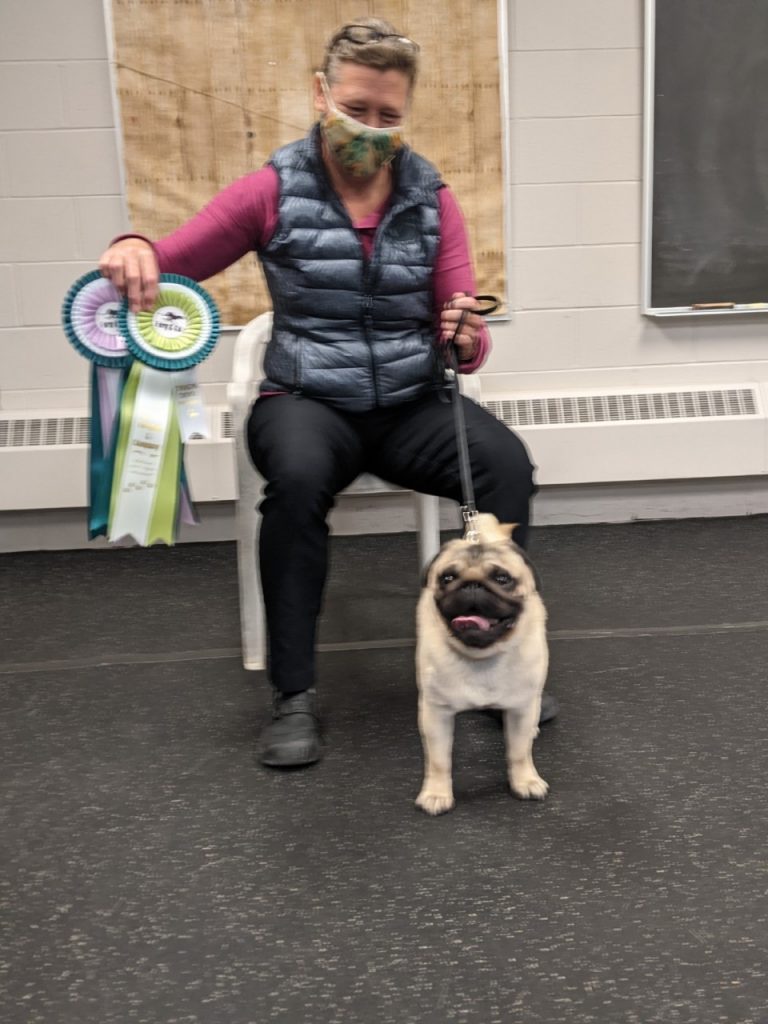
Always posed to entertain!
Kota, ETD PTK
Owner Heidi Merkli
If you are interested in doing some activities and obtaining a CKC or AKC title on your Pug. Click below to read and review the necessary tricks you can do with your Pug!
CKC Welcomes Do More With Your Dog!® Trick Dog Title Recognition Program
Effective January 1, 2020, CKC will be recognizing titles from Do More With Your Dog!®.
Trick dog appeals to all dogs and is both a fun sport and a great bonding experience with a dog and their owner/handler. The CKC is thrilled to adopt this Title Recognition Program beginning in January 1, 2020. In addition, any titles earned from Do More With Your Dog!® prior to this initial launch date will be eligible for a CKC Title Recognition as well. The CKC Office will be accepting applications on or after January 1, 2020.
The CKC is recognizing the following titles:
- Novice Trick Dog (NTD)
- Intermediate Trick Dog (ITD)
- Advanced Trick Dog (ATD)
- Expert Trick Dog (ETD)
- Trick Dog Champion (TDCH)
For more information on Do More With Your Dog!®, visit the following website: http://www.domorewithyourdog.com/trickdog/
For your dog to obtain a CKC Title and Certificate, your dog must have the following:
A CKC Registration Number, a Performance Event Number, a Canine Companion Number, a Miscellaneous Certification Number or an Event Registration Number. In addition, a completed CKC Do More With Your Dog!® Title Application Form and a fee of $20 plus applicable tax must be provided to CKC. The application form will be available on the CKC Website soon. Watch for an announcement prior to the launch date.
Above excerpt taken from the CKC website
